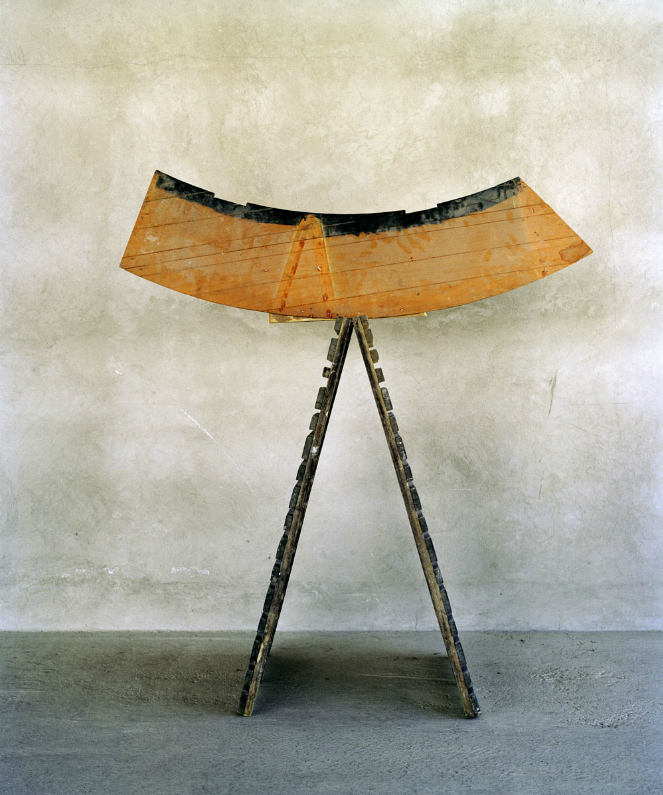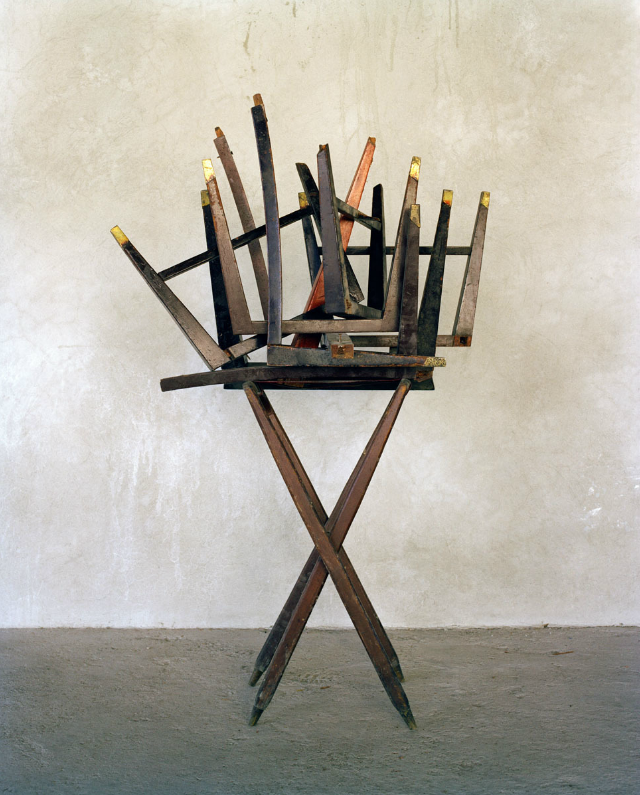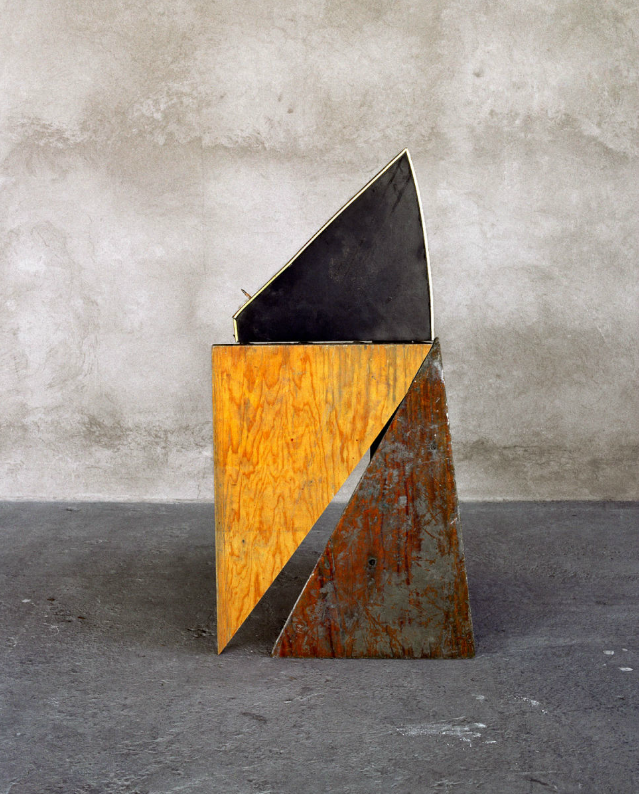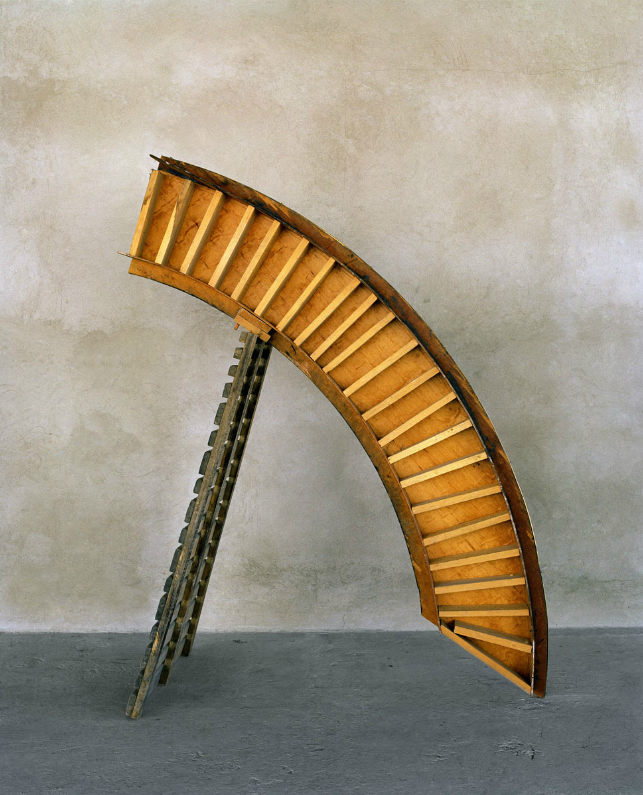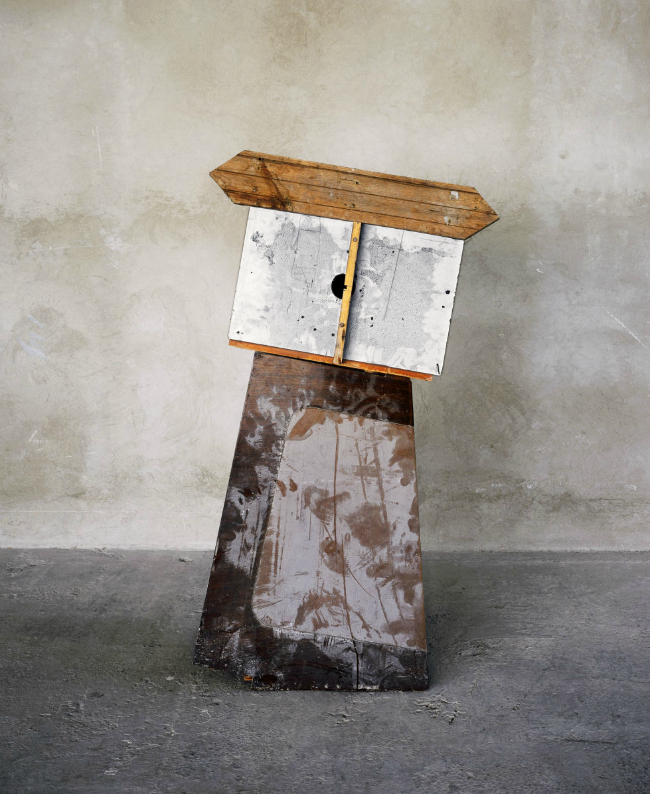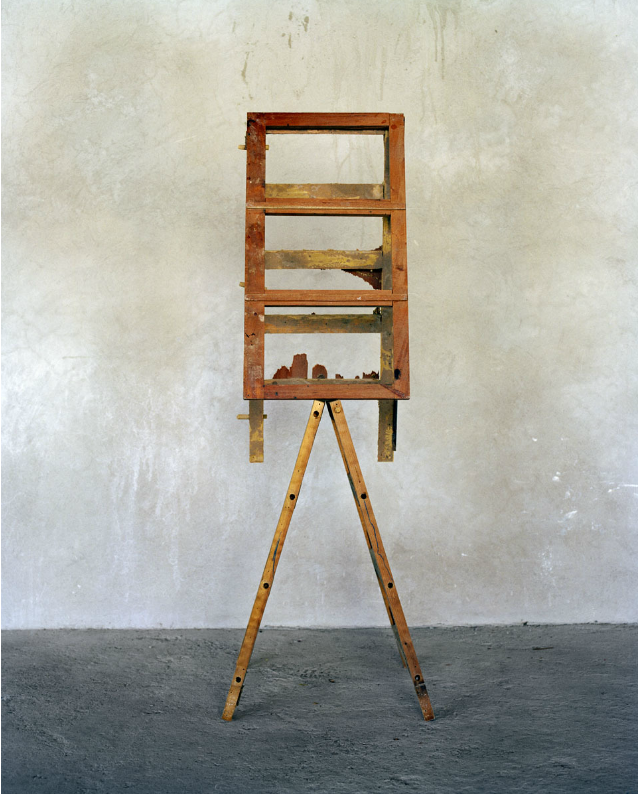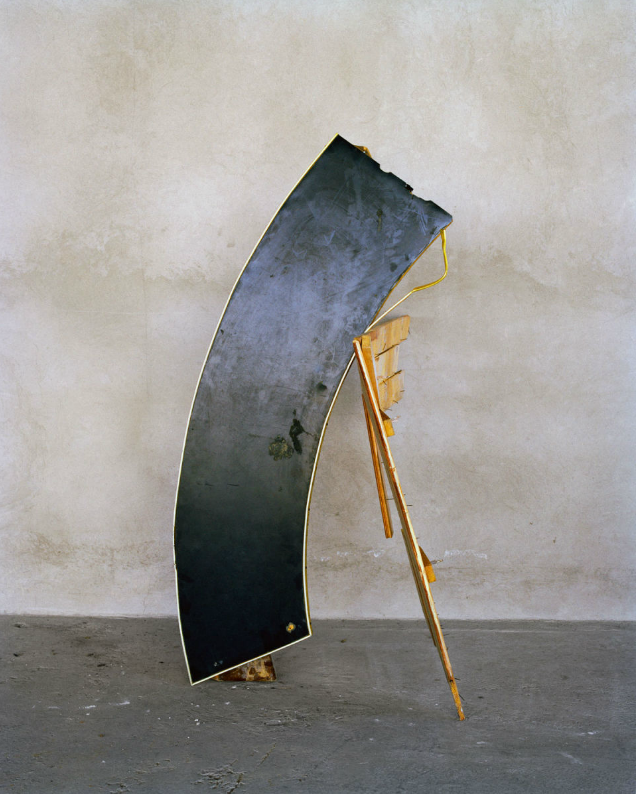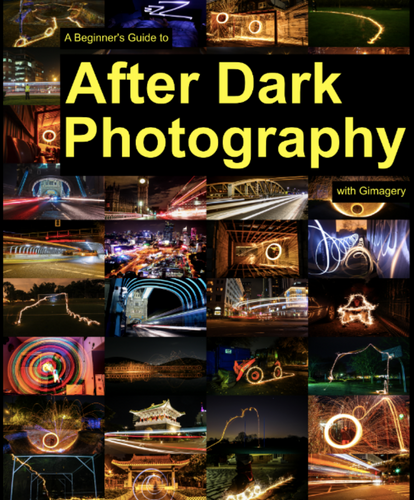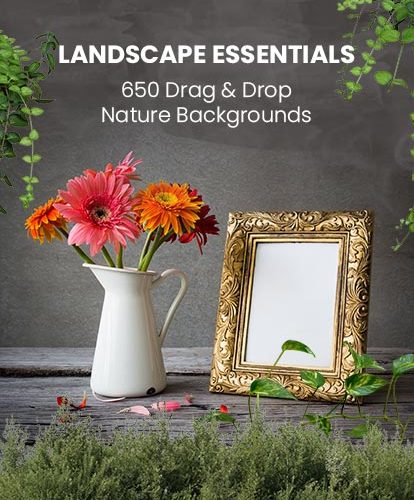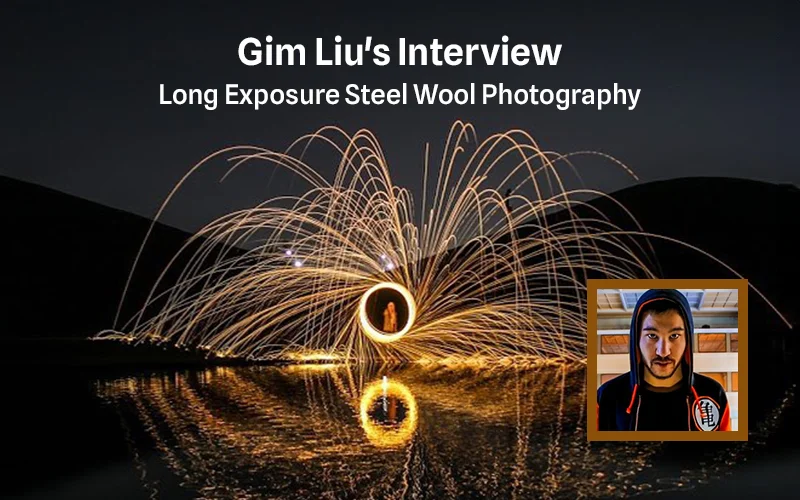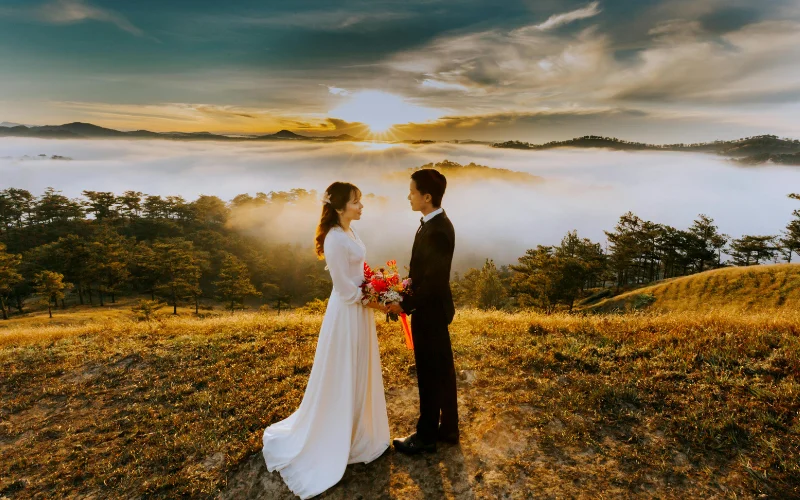An interview with Laviada on how she effectively makes a perfect photo sculpture from scratch.
In 2006, Alejandra Laviada spent time photographing the remains of a once prominent hotel in Mexico City named Hotel Bamer. A landmark of 1950s Mexico, the hotel was demolished soon after she left. From what remained after the demolition, Laviada took pieces of discarded wood and furniture to build sculptures that would serve as subjects for the subsequent series Re-Constructions.
Like the hotel they come from, the sculptures photographed in Re-Constructions are transient. Her photographs explore what it means to play with the camera’s relationship to time.
A tension is brought out by the sculptures’ vulnerability. Inches from collapse, each one is seen a beat before a leg gives out or a stool topples over. The photographs reveal, like ones that can still the folds of a windswept curtain, time’s physical bearing — only these look backward. It’s the second before that you look, the moment when not moving comes closest to resembling permanence.
I spoke to Laviada over email about Re-Constructions and her ideas about photo sculpture.
To draw, I was told one night sometime ago, you have to discard what you see in your mind and really look at what you’re seeing. We were drinking and I was sitting across from a woman that I’d eventually call my girlfriend. I tried to draw her face as I saw it then, but this drawing left me wanting. I wanted to capture what I saw and put it down as I felt it. I even abandoned everything in my mind to do so, but still, nothing. I feel the same with photography at times. I’m able to see some aspect, some detail of the world, and I go mad trying to put it in the frame neatly, usually without success. I’m telling you this because I think you’re able to see things in the world as they are, able to capture them cloudlessly — without any distraction or any false impression. What do you think? Have you ever considered photographic vision a gift? Do you think there are such things as false impressions?
One of the things I love about photography is being able to share with others how I perceive the world around me. It can be anything from a particular project I’m working on, to an image I upload on Instagram. The power of photography is that it can transform the banal and familiar into something beautiful and extraordinary.
I was recently with a group of photographers walking through the streets of Mexico City, and it was really interesting to see the things each of us were drawn to and how we chose to photograph. There were often overlaps in the things that caught our eye, but often the resulting images were surprisingly different. I’ve always been intrigued by this and thought that as photographers we’re trained to look closely at the world around us, to really notice the smallest details, or the way the light hits certain subjects.
We’re constantly scouting for new images that form in our minds, and in doing so, hope to eventually develop a photographic vision that makes each of us unique. It’s crucial to develop your own voice and remain true to the things that attract you, because otherwise the photographs don’t last, and become transient images. About false impressions, I’m not exactly sure what you mean by this. I think the term could apply to a wide range of things in photography. I try to be honest in the things I choose to photograph and present them as I want others to see them. But there are multiple realities and infinite ways of presenting a subject, so I could argue that a single view of them might give a false impression of them.
How did you get your start in photography? How would you describe your work?
I started my career in painting, which greatly influenced my photographic process. I start with a blank canvas and think about how to construct an image on it, rather that just going out to the street and photographing. Composition and color are important elements in my work, which also probably come from my years in painting.
My work is essentially about exploring the potential of sculpture through photography. I’m interested in discovering photography’s role and relationship to other artistic media and to create images that rise from the intersections and overlaps between them.
Do you ever exercise your vision? How do you make sure you’re still improving how you see?
I guess as a photographer you never stop looking. Even when I’m not taking a picture with my large camera, I’m walking down the street and photographing the things with my phone that catch my eye, or spending time with my kids and photographing spontaneous moments with them. So I would say that as a photographer you exercise your vision every day, sometimes even unconsciously.
An elegant photo sculpture example
Here are some words and phrases I wrote down before writing these questions: precarious, tension in time and in performance, delicate balance, they will eventually fall, put together, materials in play, objects arranged to be something more, recognition. Of those, delicate balance hits at something I connected with most in these photographs. I love how fragile a photo sculpture seems. I imagine that right after you photographed them, they disappeared, never seen again. How does time and entropy relate to your work? Do you see any poetic resonance in how they seem to dance around their own demise?
Entropy is an important theme across my work. Robert Smithson’s writings had a big impact on me when I first read them, and he talks a lot about time and entropy in his work. His notion of the entropic landscape resonated strongly with the urban cycles of construction and decay that I witnessed growing up in Mexico City.
I was originally drawn to spaces that were in transition or in this state of entropy, (in the process of being rebuilt at the same times as they were falling apart). I later started photographing an ephemeral photo sculpture that I created with the objects I found in each space.
Both the spaces and sculptures were impermanent by nature and meant to fall apart or be demolished soon after I photographed them.
You spend a lot of time looking at sub-structures, things built to support the larger structures that run our society: for instance, floorboards instead of the gym, crates instead of the shipping carrier. What draws your interest to these things? What do you think they might say about us when taken away from their original state?
These were objects that I found in the spaces I photographed, which were all left behind and revealed clues about the function of the space. My interest lied in transforming these forgotten objects into something different and giving them a new function.
Is there a wrong way of looking? Did I fail at drawing my girlfriend’s portrait that night because of my eyes? Can everybody be a photographer?
I don’t think there’s a wrong way of looking. Each person has their own unique vision and it’s not always easy to present it to others. I think most artists would agree that there is often a discrepancy between an image in your head (or an initial idea for a project), and the end result.
This is a natural part of any artistic process, to develop an idea and present it to others. As for the second question, I think anyone can take a good picture but not everybody can be a photographer.
A great example of a photo sculpture from Laviada
Do you think photography reveals anything about reality? What have you learned about yourself from shooting photography? Any epiphanies?
Of course. Photography is a way of presenting multiple realities, some constructed and others not.
All images © Alejandra Laviada.
If you loved the many nuances of the photo sculpture from Lavida, see more of her work here.

